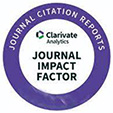THE INFLUENCE OF THE EXTRACTION TEMPERATURE ON THE RENDEMENT AND PECTIN METHOXYL CONTENTS OF WATERHYACINTH (Eichornia crassipes (Mart) Solms)
Ika Daniarsari(1*), Nurul Hidajati(2)
(1) Department of Chemistry, Faculty of Mathematic & Natural Sciences, Surabaya State University, Jl. Ketintang Surabaya, Indonesia (60231)
(2) Department of Chemistry, Faculty of Mathematic & Natural Sciences, Surabaya State University, Jl. Ketintang Surabaya, Indonesia (60231)
(*) Corresponding Author
Abstract
The purpose of this research is to find out the influence of the extraction temperature on the rendement and pectin methoxyl contents of waterhyacinth with the applied temperatures ranged from 60, 70, 80, 90 and 100 °C.The stages of this research involve extraction, precipitation, washing and drying. The pectin produced was, then, identified by reacting it with water, ethanol 96 %, NaOH and spectrophotometer IR. Its product was, then, compared to the comparing pectin. To determine the methoxyl contents, the acid - base titration was used. The resulting data were analysed and tested using One Direction Anava with SPSS 10.0 program. From the quantitative used by this study, pectin was produced. This is shown by the gel-formation. The rendements produced with the extraction temperatures of 60, 70, 80, 90 and 100 °C were 0,428 %; 0,487 %; 0,629 %; 0,774 % and 0,958% respectively. While its methoxyl contents were 3,879 %; 3,993 %; 4,413 %; 3,573 % and 2,837 %. Based on the analysed data, it was found that the treatment with the extraction temperature gives a significant influence on the rendement and pectin methoxyl contents of waterhyacinth.
Keywords
Full Text:
Full Text PdfReferences
[1] Heyne, K., 1989, Tumbuhan Berguna Indonesia Jilid I, Badan Litbang Departemen Kehutanan, Jakarta
[2] Anonim, 1989, Ensiklopedi Nasional Indonesia, Jilid 5, PT. Cipta Adi Pustaka, Jakarta
[3] Suprapti, L., 2000, Kerajinan dari Eceng Gondok, Trubus Agrisarana, Surabaya
[4] Sugesti, S., 1985, Berita Selulosa, XIX, 1, 13-17
[5] Laga, S., Djagal., W, dan Marseno, 2001, Agrosains, 14 (2), 121-127
[6] Winarno, F.G., 1988, Kimia Pangan dan Gizi, Gramedia, Jakarta
[7] Ranganna, S., 1977, Manual of Analysis of Fruits and Vegetables, McGraw Hill Book, New York
[8] Tranggono., Liuhartana, R., dan Haryadi. 1990. Bahan Tambahan Pengan (Food Addition), Pusat Antar Universitas Pangan dan Gizi UGM, Yogyakarta
[9] Sakidja, 1989, Kimia Pangan, P2LPTK Departemen Pendidikan dan Kebudayaan, Jakarta
[10] Anonim, 1995, Farmakope Indonesia, Edisi ke 4, Departemen Kesehatan Republik Indonesia
Article Metrics
Copyright (c) 2010 Indonesian Journal of Chemistry

This work is licensed under a Creative Commons Attribution-NonCommercial-NoDerivatives 4.0 International License.
Indonesian Journal of Chemistry (ISSN 1411-9420 /e-ISSN 2460-1578) - Chemistry Department, Universitas Gadjah Mada, Indonesia.












